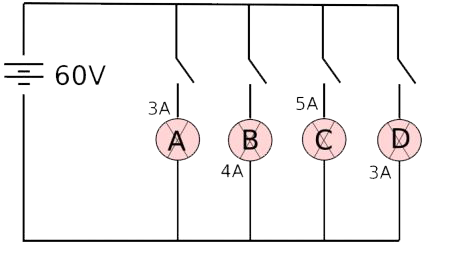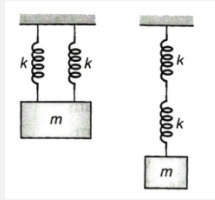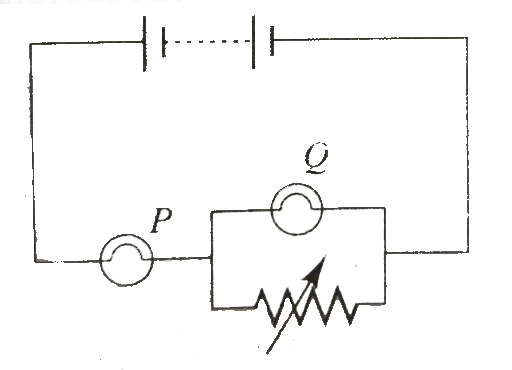How do you think the brightness of two lamps arranged in parallel compares with the brightness of two lamps arranged in series (both arrangements having one cell)?
The correct Answer is:The brightness of two lamps arranged in parallel is much more than those arranged in series
Step by step video, text & image solution for How do you think the brightness of two lamps arranged in parallel compares with the brightness of two lamps arranged in series (both arrangements having one cell)? by Physics experts to help you in doubts & scoring excellent marks in Class 10 exams.
Topper's Solved these Questions
- BOOK - LAKHMIR SINGH & MANJIT KAURCHAPTER - ELECTRICITY EXERCISE - Very Short Answer Type Questions1videos
ELECTRICITY
- BOOK - LAKHMIR SINGH & MANJIT KAURCHAPTER - ELECTRICITY EXERCISE - Short Answer Type Questions2videos
ELECTRICITY
- BOOK - LAKHMIR SINGH & MANJIT KAURCHAPTER - ELECTRICITY EXERCISE - Sample Problem1videos
ELECTRICITY
- BOOK - LAKHMIR SINGH & MANJIT KAURCHAPTER - MAGNETIC EFFECT OF ELECTRIC CURRENT EXERCISE - NCERT BOOK2videos
MAGNETIC EFFECT OF ELECTRIC CURRENT
Similar Questions
In the given circuit, A, B, C and D are four lamps connected with a battery of 60V.

Analyse the circuit to answer the following questions
(i) What kind of combination are the lamps arranged in (series or parallel)?
(ii) Explain with reference to your above answer, what are the advantages (any two) of this combination of lamps?
(iii) Explain with proper calculations which lamp glows the brightest?
(iv) Find out the total resistance of the circuit.View SolutionTwo identical springs are connected in series and parallel as shown in the figure . If fsandfp are frequencies of arrangements, what is fsfp ?
 View Solution
View Solution
Knowledge Check
- Question 1 - Select One
Two tungsten lamps A and B of resistances R1 and R2 respectively are connected in a circuit of negligible internal resistance, if R1>R2
(i) The lamp A will glow brightly if lamps are connected in series
(ii) the lamb A will glow brightly if lamps are connected in parallel
(iii) the lamp B will glow brightly if lamps are connected in series.
(iv) the lamb B will glow brightly if lamps are connected in parallelA(i),(ii)B(i),(iv)C(i), (iii)D(ii),(iii) - Question 2 - Select One
The circuit shownin Fig. 7.33 contains a battery , a rheostat , and two identical lamps. What will happen to the brightness of the lamps if the resistance of the rheostat is increased?
 ALamp P - Less bright , Lamp Q - BrighterBLamp P - Less brighter , Lamp Q - Less brighterCLamp P - Brighter , Lamp Q - Less brighterDLamp P - No change , Lamp Q - Brighter
ALamp P - Less bright , Lamp Q - BrighterBLamp P - Less brighter , Lamp Q - Less brighterCLamp P - Brighter , Lamp Q - Less brighterDLamp P - No change , Lamp Q - Brighter - Question 3 - Select One
The arrangement of the first two layers, one above the other, in hcp and cop arrangements is
Aexactly same in both casesBpartly same and partly differentCdifferent from each otherDnothing definite.
If current flows through two lamps arranged:
(a) in series,
(b) in parallel,
and the filament of one lamps breaks, what happens to the other lamp? Explain your answer.View SolutionTwo exactly similar electric lamps are arranged (i) in parallel, and (ii) in series. If the parallel and series combination of lamps are connected to 220V supply line on by one, what will be the ratio of electric power consumed by them?
View SolutionConsider two arrangements of N identical resistors, one in parallel and the other in series, Each of these arrangements are connected to batteries of the same voltage.The ratio of power dissipated in the parallel arrangement to the series arrangement is
View SolutionConsider two arrangements of N identical resistors one in parallel and the other in series. Each of these arrangements are connected to batteries of the same voltage. The ratio of power dissipated in the parallel arrangement to the series arrangement is:
View SolutionTwo identical bulbs A and B are connected in series across a source of emf E. now, bulb B is removed from the circuit. Compare the brightness of bulb A in both arrangements .
View Solution

